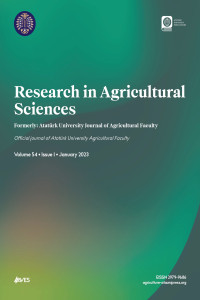Erzurum İli Temel Coğrafi Özellikleri ve Potansiyel İşlemeli Tarım Alanı Varlığı
Bu çalışmanın temel amacı, güncel veriler kullanarak Erzurum ilinin temel coğrafi özelliklerinin belirlenmesi ile, analitik hiyerarşik süreç AHP-Fuzzy yaklaşımı ve CBS ortamında bindirme analiz yöntemleri ile işlemeli tarım faaliyetlerine uygun potansiyel tarım alanlarının belirlenmesini içermektedir. Yaklaşık 25.000 km2 yüz ölçümüne sahip Erzurum iline ait işlemeli tarıma uygun potansiyel sahaların belirlenmesine yönelik olarak eğim, derinlik, erozyon, ana materyal olmak üzere dört adet arazi özelliği ve organik madde, hacim ağırlığı, bünye, pH ve kireç olmak üzere beş adet toprak özelliği toplamda 9 adet kriter kullanılmıştır. Yükselti ve eğim özelliklerinin belirlenmesi amacıyla 10 m piksel çözünürlüklü sayısal yükseklik modeli (SYM), sayısal jeoloji ve toprak haritaları, CORINE arazi kullanım arazi örtüsü, uzun yıllara ait meteorolojik veriler ile alandan alınan 329 adet toprak örnekleri kullanılmıştır. Elde edilen sonuçlara göre, toplam il sınırına ait alanın %19.64’ü işlemeli tarıma S1 ve S2 düzeylerinde yani çok uygun ve uygun olarak belirlenirken, %49.45’i ise işlemeli tarımsal faaliyetlere uygun olmadığı (N) belirlenmiştir.
Anahtar Kelimeler:
Fuzzy-AHP, Potansiyel işlemeli tarım alanları, Erzurum
Basic Geographical Properties and Determination of Potential Arable Lands of Erzurum Province
The main aim of the current study was to determine basic geographic properties and potential arable lands of Erzurum province using the AHP-Fuzzy approach and GIS overlaying analysis by taking into consideration of current data. In order to detect potential arable lands of Erzurum province which covers about 25 000 km2, 9 criteria were used that four of them are slope, depth, erosion and parent material for land properties while, organic matter, bulk density, soil erosion, pH, and calcium carbonate content were concerned as soil features. In this study, to generate slope and elevation, digital elevation model (DEM) which has 10 m pixel size was used. In addition, land use land cover, digital geology and soil maps, long term meteorological data and 329 soil samples were used. According to obtained results, it was found that 19.64% of the total area is highly suitable and suitable (S1 and S2) whereas, 49.45% of the it is not suitable (N) for cultivation in the study area.
Keywords:
Fuzzy-AHP, Potential arable lands, Erzurum,
___
- Buckley, J. J., 1985. Fuzzy hierarchica lanalysis. Fuzzy Sets And Systems 17(3):233-247.
- Chang, D. Y., 1996. Applications of the extent analysis method on fuzzy AHP. European Journal Of Operational Research 95(3):649-655.
- Dağdeviren, M., 2007. Bulanık analitik hiyerarşi prosesi ile personel seçimi ve bir uygulama. Gazi Üniversitesi Mühendislik-Mimarlık Fakültesi Dergisi 22(4):791-799.Deng, H., 1999. Multi criteria analysis with fuzzy pair wise comparison. In Fuzzy Systems Conference Proceedings, 1999 IEEE International 2:726-731.
- Elalfy, Z., Elhadary, R., Elashry, A., 2010. Integrating GIS and MCDM to Deal with landfill site selection. International Journal of Engineering&Technology 10(6):32–42.FAO, 1989. Gidelines for land use planning. Inter departmental Working Group on Land Planning, FAO, Rome.
- Kahraman, C., Cebeci, U., Ulukan, Z., 2003. Multi-criteria supplier selection using fuzzy AHP. Logistics information management 16(6):382-394.
- Kahraman, C., Cebeci, U., Ruan, D., 2004. Multi-attribute comparison of catering service companies using fuzzy AHP: Thecase of Turkey. International Journal of Production Economics 87(2):171-184.
- Mallants, D., B.P. Mohanty, D. Jacques, J. Feyen., 1996. Spatial variability of hydraulic properties in a multi-layered soil profile. Soil Science, 161(3), 167-181. Malczewski, J.,Rinner, C., 2015. Multi criteria decision analysis in geographic information science. New York: Springer.
- Newhall, F., Berdanier, C.R., 1996. Calculation of soil moisture regimes from the climatic record. Soil Survey Investigations Report No. 46, National Soil Survey Center, Natural Resources Conservation Service, Lincoln, NE.
- Özbek, A.K., Öztaş, T., 2014. Tarım arazilerinin amaç dışı kullanımı; Erzurum örneği. Ekoloji, 13(52):1-6.
- Renard, K.G.,Foster, G.R., Weessies, G.A., McCool, D.K., Yoder, D.C., 1997. Predicting Soil Erosion by Water: A guideto to conservation planning with the Revised Universal Soil Loss Equation (RUSLE). U.S. Department of Agriculture, Agriculture Handbook 703.
- Saaty, T.L., 1980. The Analytic Hierarchy Process, McGraw-Hill, New York, pp.37-85.
- TÜİK, 2010. Web sitesi. Bitkisel üretim istatistikleri. http://www.tuik.gov.tr/bitkiselapp/bitkisel.zul. Erişim Tarihi: 27.08.2018.
- TÜİK, 2018. Web sitesi. Bitkisel üretim istatistikleri. http://www.tuik.gov.tr/bitkiselapp/bitkisel.zul. Erişim Tarihi: 27.08.2018.
- Van Wambeke, A.R., 2000. The Newhall Simulation Model for estimating soil moisture & temperature regimes. Department of Crop and Soil Sciences.Cornell University, Ithaca, NY.
- Van Laarhoven, P.J.M., Pedrycz, W., 1983. A fuzz yextension of Saaty'spriority theory. Fuzzy set sand Systems 11(1-3):229-241.
- Wilding, L.P., 1985. Spatial variability: it'sdocumentation, accommodation and implicationto soil surveys. In: Soil Spatial Variability. (Eds: Nielsen, D.R. and J. Bouma) Pudoc, Wageningen, The Netherlands, p. 166-194.
- Wischmeier, W.H., Smith, D.D., 1978. Predicting Rain fall Erosion Losses – A Guide for Conservation Planning. USDA, Agricultural Handbook 537. Washington.
- Yıldız, N., Akbulut, Ö., Bircan, H., 1998. İstatistiğe giriş. Erzurum: Şafak Yayınevi.
- Yayın Aralığı: Yılda 3 Sayı
- Başlangıç: 2023
- Yayıncı: Atatürk Üniversitesi Ziraat Fakültesi
Sayıdaki Diğer Makaleler
Güneydoğu Anadolu Bölgesi’nde Kamu Tarım Yatırımlarının Dağılımının Gini Katsayısı ile Ölçülmesi
Farklı Arazi Kullanımı Altındaki Podzolik Toprakların Kalite Parametrelerinin Belirlenmesi
Ekmeğin Besinsel Özelliklerinin İyileştirilmesi
Hacer MERAL, Mehmet Murat KARAOĞLU
Erzurum Kent Halkının Kış Aylarında Rekreasyonel Taleplerinin Belirlenmesi
Hasan YILMAZ, Ayşegül AKSU, Sena Nur ANGIN
Cüneyt CİVELEK, Ertan YILDIRIM
Erzurum İli Temel Coğrafi Özellikleri ve Potansiyel İşlemeli Tarım Alanı Varlığı
Orhan DENGİZ, İnci DEMİRAĞ TURAN, Barış ÖZKAN
Emine İKİKAT TÜMER, Adem AKSOY
Zeolitin Farklı Tekstür Sınıfındaki Toprakların Fiziksel Özellikleri Üzerine Etkileri
